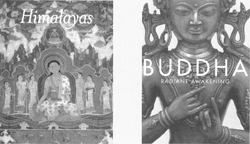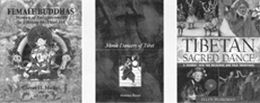The Buddha and Buddhist culture have inspired centuries of artists and, more recently, photographers.Buddha (Welcome Books, 2003, $29.95 cloth) contains 155 color photographs by Jon Ortner, from the giant gold Maha Muni Buddha in Mandalay—said to be the only image of Gautama made in his lifetime—to a fourteenth-century Siamese stone Buddha head ensnared in the roots of a bodhi tree. The satin-bound gift book includes informative captions, sayings of the Buddha, and an introduction by Vipassana teacher Jack Kornfield, a former Thai monk.
Photographer Don Farber knows Tibetan culture intimately (his wife is Tibetan, and he has long photographed the Tibetan community, including the Dalai Lama). Tibetan Buddhist Life (Dorling Kindersley, 2003, $30.00 cloth), with more than two hundred photographs, explores the history, practice, and influence of Tibetan Buddhism, and includes rare interviews with lamas from the last generation trained in Tibet. A portion of the proceeds go to the Tibet Fund, for humanitarian assistance and cultural preservation. 
Offerings: Buddhist Wisdom for Every Day (Stewart, Tabori & Chang, November 2003, $29.95 cloth) is a daybook with 365 of Danielle and Olivier Föllmi’s color images of monks, villagers, and vistas in the Himalayas, along with pithy quotes from past and present masters including Milarepa, Kalu Rinpoche, and Pema Chödrön.
Pratapaditya Pal, one of the world’s leading experts on Buddhist and Hindu art, curated a major show of Himalayan art at the Art Institute of Chicago that is now at the Smithsonian’s Sackler Gallery in Washington, DC, through January 11, 2004. Pal’s 308-page exhibition catalog,Himalayas: An Aesthetic Adventure (University of California Press, 2003, $65.00 cloth, $39.95 paper) offers a sweeping view of painting, sculpture, and ritual objects from the sixth to the nineteenth centuries. More than two thirds of the artworks are on public display for the first time. 
Pal is among the scholars represented in Buddha: Radiant Awakening (Yale University Press, 2003, $35.00 paper), an exhibition catalog edited by Jackie Menzies of the Art Gallery of New South Wales in Australia. The theme of radiance—manifestation of the awakened mind—carries through 150 artworks and essays on everything from Buddhist cosmology to digital dharma.
In Female Buddhas: Women of Enlightenment in Tibetan Mystical Art (Clear Light Publishers, 2003, $39.95 cloth, $29.95 paper), renowned Tibetologist Glenn Mullin and Jeff Watt, a leading expert on Tibetan iconography (see “Virtual Treasures,” page 26), explore the role of female deities in Tibetan Buddhist art and practice. Illustrations include Marcia Keegan’s photographs of Tibet and more than sixty artworks from the Shelley and Donald R. Rubin Collection. 
Two recent books focus on sacred dance (cham) in the Tantric tradition of Tibetan Buddhism. In Monk Dancers of Tibet (Shambhala Publications, 2003, $29.95 cloth), French-born monk Matthieu Ricard unpacks the significance of these storytelling dances in transmitting the dharma. His spectacular color photographs follow the monk dancers of Shechen Monastery in Kathmandu, who are dedicated to preserving the practice. In Tibetan Sacred Dance: A Journey into the Religious and Folk Traditions (Inner Traditions, 2002, $29.95 paper), Ellen Pearlman, who studied with the ritual dance master at Namgyal, the Dalai Lama’s monastery in Dharamsala, India, examines the history, rituals, and iconography of cham, touching on how the traditional forms are influencing Tibetan artists today.
Zen Art Practice
 Tricycle staffer Seiko Susan Morningstar and author Myochi Nancy O’Hara met as residents of Dai Bosatsu, a Zen Monastery in New York’s Catskill Mountains. Now they have collaborated on a kit for practicing sumi-e, the traditional Zen art of ink painting. Zen by the Brush: A Japanese Painting and Meditation Set (Stewart, Tabori & Chang, $14.95) includes a book with instructions, meditative verses, and Morningstar’s paintings, for inspiration. The kit comes with a brush (here the medium is water, not ink) and a painting board that teaches nonattachment: The images vanish as they dry.
Tricycle staffer Seiko Susan Morningstar and author Myochi Nancy O’Hara met as residents of Dai Bosatsu, a Zen Monastery in New York’s Catskill Mountains. Now they have collaborated on a kit for practicing sumi-e, the traditional Zen art of ink painting. Zen by the Brush: A Japanese Painting and Meditation Set (Stewart, Tabori & Chang, $14.95) includes a book with instructions, meditative verses, and Morningstar’s paintings, for inspiration. The kit comes with a brush (here the medium is water, not ink) and a painting board that teaches nonattachment: The images vanish as they dry.
Thank you for subscribing to Tricycle! As a nonprofit, we depend on readers like you to keep Buddhist teachings and practices widely available.